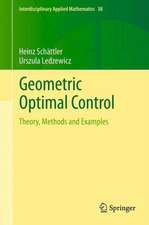The Early Period of the Calculus of Variations
Autor Paolo Freguglia, Mariano Giaquintaen Limba Engleză Paperback – 30 mai 2018
The authors begin in 1697 with Johann Bernoulli’s work on the brachystochrone problem and the events leading up to it, marking the dawn of the calculus of variations. From there, they cover key advances in the theory up to the development of Lagrange’s δ-calculus, including:
• The isoperimetrical problems
• Shortest lines and geodesics
• Euler’s Methodus Inveniendi and the two Additamenta
Finally, the authors give the readers a sense of how vast the calculus of variations has become in centuries hence, providing some idea of what lies outside the scope of the book as well as the current state of affairs in the field.
This book will be of interest to anyone studying the calculus of variations who wants a deeper intuition for the techniques and ideas that are used, as well as historians of science and mathematics interested in the development and evolution of modern calculus and analysis.
| Toate formatele și edițiile | Preț | Express |
|---|---|---|
| Paperback (1) | 781.77 lei 6-8 săpt. | |
| Springer International Publishing – 30 mai 2018 | 781.77 lei 6-8 săpt. | |
| Hardback (1) | 787.15 lei 6-8 săpt. | |
| Springer International Publishing – 5 iul 2016 | 787.15 lei 6-8 săpt. |
Preț: 781.77 lei
Preț vechi: 953.37 lei
-18% Nou
Puncte Express: 1173
Preț estimativ în valută:
149.58€ • 156.20$ • 123.53£
149.58€ • 156.20$ • 123.53£
Carte tipărită la comandă
Livrare economică 15-29 aprilie
Preluare comenzi: 021 569.72.76
Specificații
ISBN-13: 9783319817798
ISBN-10: 3319817795
Ilustrații: XII, 293 p. 59 illus.
Dimensiuni: 155 x 235 mm
Greutate: 0.44 kg
Ediția:Softcover reprint of the original 1st ed. 2016
Editura: Springer International Publishing
Colecția Birkhäuser
Locul publicării:Cham, Switzerland
ISBN-10: 3319817795
Ilustrații: XII, 293 p. 59 illus.
Dimensiuni: 155 x 235 mm
Greutate: 0.44 kg
Ediția:Softcover reprint of the original 1st ed. 2016
Editura: Springer International Publishing
Colecția Birkhäuser
Locul publicării:Cham, Switzerland
Cuprins
Preface.- Some Introductory Material.- The Brachystochrone Problem: Johann and Jakob Bernoulli.- Isoperimetrical Problems: Jakob and Johann Bernoulli.- Shortest Lines and Geodesics.- Euler's Memoirs of 1738 and 1741.- Euler's Method us Inveniendi.- Lagrange's δ-Calculus.- Bibliography.- Index of Names.- Subject Index.
Recenzii
“The book presents an accurate description of the ideas and methods developed to face the first variational problems, essentially from the Brachistochrone in the seventeenth century to the very first years of the nineteenth century, covering overall a little more than a century. … The book is the result of the fruitful cooperation between a specialist in the history of sciences and a well-known researcher in the Calculus of Variations … .” (Arrigo Cellina, Mathematical Reviews, May, 2017)
Textul de pe ultima copertă
This monograph explores the early development of the calculus of variations in continental Europe during the Eighteenth Century by illustrating the mathematics of its founders. Closely following the original papers and correspondences of Euler, Lagrange, the Bernoullis, and others, the reader is immersed in the challenge of theory building. We see what the founders were doing, the difficulties they faced, the mistakes they made, and their triumphs. The authors guide the reader through these works with instructive commentaries and complements to the original proofs, as well as offering a modern perspective where useful.
The authors begin in 1697 with Johann Bernoulli’s work on the brachystochrone problem and the events leading up to it, marking the dawn of the calculus of variations. From there, they cover key advances in the theory up to the development of Lagrange’s δ-calculus, including:
• The isoperimetrical problems
• Shortest lines and geodesics
• Euler’s Methodus Inveniendi and the two Additamenta
Finally, the authors give the readers a sense of how vast the calculus of variations has become in centuries hence, providing some idea of what lies outside the scope of the book as well as the current state of affairs in the field.
This book will be of interest to anyone studying the calculus of variations who wants a deeper intuition for the techniques and ideas that are used, as well as historians of science and mathematics interested in the development and evolution of modern calculus and analysis.
The authors begin in 1697 with Johann Bernoulli’s work on the brachystochrone problem and the events leading up to it, marking the dawn of the calculus of variations. From there, they cover key advances in the theory up to the development of Lagrange’s δ-calculus, including:
• The isoperimetrical problems
• Shortest lines and geodesics
• Euler’s Methodus Inveniendi and the two Additamenta
Finally, the authors give the readers a sense of how vast the calculus of variations has become in centuries hence, providing some idea of what lies outside the scope of the book as well as the current state of affairs in the field.
This book will be of interest to anyone studying the calculus of variations who wants a deeper intuition for the techniques and ideas that are used, as well as historians of science and mathematics interested in the development and evolution of modern calculus and analysis.
Caracteristici
Thoroughly examines key early developments in the calculus of variations, from the brachystochrone problem to Lagrange’s d-calculus
Guides the reader through the original works of Euler, Lagrange, the Bernoullis, and others that built up the theory, with instructive commentaries and supplemental information
Offers a unique perspective as a collaboration between a historian of mathematics and a mathematician
Provides insight for those studying the calculus of variations by naturally motivating its fundamental tools and concepts
Includes supplementary material: sn.pub/extras
Guides the reader through the original works of Euler, Lagrange, the Bernoullis, and others that built up the theory, with instructive commentaries and supplemental information
Offers a unique perspective as a collaboration between a historian of mathematics and a mathematician
Provides insight for those studying the calculus of variations by naturally motivating its fundamental tools and concepts
Includes supplementary material: sn.pub/extras














